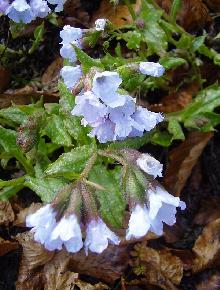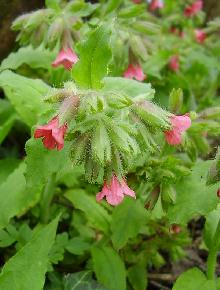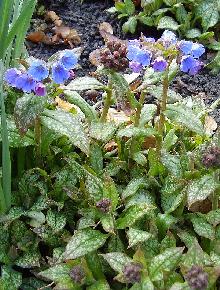Lungwort
By Debs Cook

Pulmonaria officinalis
In my garden, I know that spring is well and truly on the way when I see the first leaves of the lungwort, which are followed, not long after, by a cheery bright splash of colour that brings the bumble bees out looking for nectar. Once seen, I know that the sunshine and warmer days are not too far away.
Lungwort is one of those herbs that are grown by many people without them knowing it. I don't mean that the plant is secretive or invisible but that is often grown just as a pretty spring perennial flower. The plant is available in almost all garden centres and plant specialists, but it gets referred to simply by its Latin name of pulmonaria. So general gardeners are seemingly unaware that pulmonaria is a herb and has uses beyond the decorative.
History
Lungwort is not a native of the UK but comes from mainland Europe and Eurasia.
The name pulmonaria is derived from the Latin pulmo which means lung.
Incidentally, did you know that 'wort' ending simply means plant? Other examples are Mugwort and Soapwort.
From 1348-1350 the 'Black Death' or Bubonic Plague swept through Europe killing an estimated 4.2 million people in England alone. Lungwort was one of the herbs used alongside wormwood in attempts to cure the plague in Europe.
In (1493-1541) Paracelsus listed lungwort in his Doctrine of Signatures. In much the same way as Goldenrod was said to cure jaundice due to its yellow colouring, lungwort was said to cure pulmonary disease because the spotted leaves resembled diseased lungs. Lungwort became more widely used in Europe during the 16th and 17th centuries for treating diseases of the breast and lungs. In England in the 17th century lungwort became known as Jerusalem Cowslip and was held in high regard as a treatment for asthma and bronchial complaints.
Folklore

'Blue Mist'
Lungwort in some regions was called "Herb of Mary", and was said to be used as proof for revealing if a person was a witch. In the past, many wild flowers and herbs were associated with the Virgin Mary and St. Bridget, and all of them were worn or used as a protection against witches and evil spirits.
Lungwort has a variety of folk names, amongst them are Soldiers and Sailors, Lung Moss (not to be confused with actual lungmoss, see medicinal info below), Spotted Dog, Joseph and Mary, and Bethlehem Sage. It is also called Mary's Tears because the white spots on the leaves resemble tear stains, and the changing colour of the flowers from pink to blue represent blue eyes becoming reddened from weeping.
Description
A member of the borage (boraginaceae) family, lungwort is one of the herbs that thrive in shady and damp parts of the garden and, indeed, prefers such conditions to dry and sunny ones. It also loves chalky soil and makes a useful ground cover plant.
Depending on variety, Lungwort ranges in height from 15 - 40cm with a spread of 45 - 60cm. It has five-petaled flowers that extend in clusters as short bells from the green, hairy bracts and stems. Lungwort has creeping rhizome's that can help it to spread. Their leaves, which are pointed ovals and in some cases thin (similar to the leaves of plantain), range in colour from plain green, through a whole host of greens with spots, blotches and smudges of white, cream and silvery grey. The colours of the flowers range from pure white through to shades of red, pink, violet and a full range of blues
Pulmonaria's consist of several commonly grown species which include P. angustifolia, P. longifolia, P. rubra, P. saccharata, P. officinalis and P. vallarsae.
Growing

'Red Start'
Lungwort can be grown in pots, as long as the pot is large enough to allow the creeping roots to spread and has sufficient space to prevent the plant from becoming pot bound too soon. A wonderful hardy perennial, lungwort prefers a moist but well drained soil with a good amount of leaf mould added. The flowers will cross pollinate, so if you have several varieties in your garden and you want to increase a particular plant, it is best to do so from root divisions and not from seed.
To keep plants healthy and full of vigor it's recommended that you lift, divide and replant lungwort every 4 to 5 years. Lungwort self seeds freely and can quickly take over a garden if left unchecked. Seeds can be sown directly into the ground from early spring or you can divide existing plants in the autumn.
Lungwort can be prone to powdery mildew in dry periods and when the leaves die back come autumn. The best way to treat this is to remove the diseased leaves and dispose of them, either by burning or throwing away. Do not put the diseased leaves into your compost bin!
General Use
Lungwort is a good herb to grow in gardens that are plagued with slugs and snails. Some say that these little molluscs don't like the hairy foliage, but it is more likely that they avoid the toxic alkaloids and saponins that are present in the plant.
The young leaves can be picked and used to make soups and salads. In medieval times, lungwort was a popular pot herb for adding to stews and savoury dishes.
The flowers are good for spring floral arrangements and both the flowers and leaves can be dried for adding to pot-pourri.
Medicinal Use
Anybody reading Culpeper's Complete Herbal can be forgiven for being a little confused when they read his account of Lungwort, P. Officinalis:-
"Lungwort is a kind of moss that groweth on sundry sorts of trees, especially oaks and beeches, with broad, greyish, tough leaves diversely folded, crumpled, and gashed in on the edges, and some spotted also with many small spots on the upper side. It was never seen to bear any stalk or flower at any time."

'Lewis Palmer'
Although Culpeper does state that lungwort is useful for treating diseases of the lungs and for coughs and wheezing, I'd hazard a guess that he was referring to something more like the lungmoss (Lobaria pulmonaria), a lichen that also gets referred to as Lungwort in some publications, rather than P. officinalis.
Medicinally only the leaves are used. They contain saponins, allantoins, silica, flavonoids, tannins, vitamin C and mucilage. Lungwort has long been used as a herbal treatment for lung diseases, such as tuberculosis, asthma and coughs. The success of lungwort in treating these conditions may be down to the fact that it contains antibiotics which act against bacteria. The silica and allantoin content of lungwort may be the reason this herb is recommended for its wound healing properties and for use externally for treating eczema, hemorrhoids, varicose veins, wounds and burns. The leaves are astringent and have been used to help staunch bleeding. When made into a tea, the leaves are also used as an expectorant, to relieve congestion and ease a sore throat (often mixed with coltsfoot and cowslip flowers).
There is an excellent remedy for Thyme & Lungwort Syrup on page 84 of The Herb Society's Home Herbal by Penelope Ody MNIMH (ISBN 0-7513-0166-3). This syrup is brilliant for treating chesty coughs. It is made with dried lungwort leaves, thyme, cowslip flowers and liquorice, amongst other ingredients.
Caution: It is now known that lungwort, like one of its sister plants in the borage family, comfrey (Symphytum officinale), contains toxic pyrrolizidin alkaloids, so its internal use without medical supervision is not recommended. It is also not advised to take this herb over a long period of time or if you are pregnant or a nursing mother.
